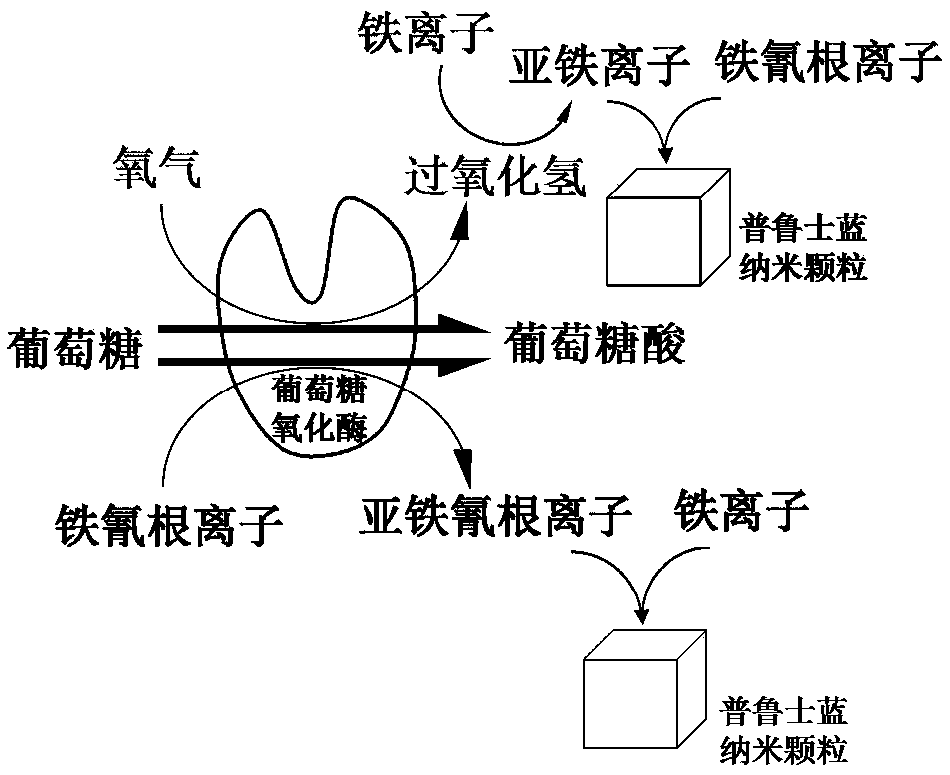Colorimetric sensing method for generating inorganic nanoparticles based on enzyme catalytic induction
An inorganic nanoparticle and colorimetric sensing technology, applied in the field of colorimetric biosensing, can solve problems such as difficult detection and limited PB application, and achieve low cost, fast color change time, and good anti-interference effect
- Summary
- Abstract
- Description
- Claims
- Application Information
AI Technical Summary
Problems solved by technology
Method used
Image
Examples
Embodiment 1
[0044] First prepare 50mM MES buffer solution with ultrapure water, and adjust the pH to 3.0 with dilute hydrochloric acid and potassium hydroxide. Use 50mM MES buffer solution to prepare 0.5mM, 1.5mM ferric chloride solution and 0.5mM, 1.5mM potassium ferricyanide solution, 0.5mM ferrous chloride solution, 1.1mg / mL glucose oxidase solution, 22mM glucose solution and 21mM H 2 O 2 Solution.
[0045] First in order to verify the method as figure 1 There are two ways to enhance the effect together. Take 50μL of 0.5mM ferric chloride and 50μL of 0.5mM potassium ferricyanide solution respectively, prepare 4 portions, respectively without adding (sample 1), adding 5μL of 22mM glucose solution (sample 2), adding 5μL of 1.1mg / mL glucose oxidase solution (Sample 3), add 5 μL of 22 mM glucose solution and 5 μL of 1.1 mg / mL glucose oxidase solution (sample 4). After reacting for 10 minutes, measure the ultraviolet-visible absorption spectrum, such as figure 2 Shown. From figure 2 (a) I...
Embodiment 2
[0051] To buy semi-sweet red wine from the supermarket, first filter the red wine through a 0.2μm pore filter 3 times, and then dilute it 1 times with 50mM MES buffer solution. Take 50μL of 1.5mM ferric chloride, 50μL of 1.5mM potassium ferricyanide and 5μL of 1.1mg / mL glucose oxidase mixture, take 5μL of the diluted red wine solution and add it, and measure the UV-visible absorbance value after 10 minutes of reaction. Figure 5 . Taking the absorbance value at 706 nm, according to the equation in Example 1 and the dilution factor, the glucose content is calculated to be 27.52±0.04mM.
Embodiment 3
[0053] To buy sweet red wine from the supermarket, first filter the red wine through a 0.2μm pore filter 3 times, and then dilute it 1 times with 50mM MES buffer solution. Take 50μL of 1.5mM ferric chloride, 50μL of 1.5mM potassium ferricyanide and 5μL of 1.1mg / mL glucose oxidase mixture, take 5μL of the diluted red wine solution and add it, and measure the UV-visible absorbance value after 10 minutes of reaction. Figure 5 . Taking the absorbance value at 706 nm, according to the equation in Example 1 and the dilution factor, the glucose content is calculated to be 34.62±0.07mM.
PUM
 Login to View More
Login to View More Abstract
Description
Claims
Application Information
 Login to View More
Login to View More - R&D
- Intellectual Property
- Life Sciences
- Materials
- Tech Scout
- Unparalleled Data Quality
- Higher Quality Content
- 60% Fewer Hallucinations
Browse by: Latest US Patents, China's latest patents, Technical Efficacy Thesaurus, Application Domain, Technology Topic, Popular Technical Reports.
© 2025 PatSnap. All rights reserved.Legal|Privacy policy|Modern Slavery Act Transparency Statement|Sitemap|About US| Contact US: help@patsnap.com



